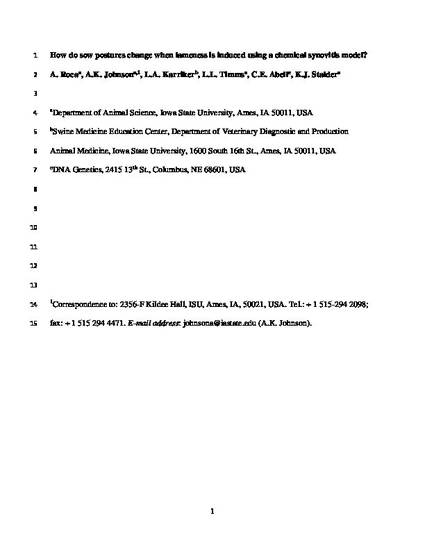
Lameness detection using objective behavioral parameters provides an opportunity for timely treatment which, in turn, could improve sow welfare and reduce economic expense. Therefore, the objectives of this study were to (1) determine sow posture frequencies and duration (2) ascertain the postural sequence and time when standing to lying and vice versa and (3) to record how long it took for sows to access feed when lameness was induced using a chemical synovitis model. Lameness was induced in 24 multiparous, non-pregnant, crossbred 22 Newsham, maternal-cull sows by injecting amphotericin B in the distal interphalangeal joint 23 space. The experimental design was a 3 (days) x 2 (rear feet) factorial arrangement where sow was the experimental unit. All sows were video recorded in their home pens continually over a 12-h period (0600 to 1800 h) on the sound day (1 d pre-induction), on the most lame day (1 d post-induction) and the resolution day (6 d post-induction). Three postures (standing, lying and sitting), an unknown category, three lying positions (lying left lateral, lying right lateral and lying sternal), time to change postures, the number of postures used in a behavioral sequence and time to reach feeder on the raised step were collected. Sows spent less time standing on the most lame day compared to sound and resolution days (P < 0.05). Sows performed fewer standing and sitting postural adjustments on the most lame day compared to the sound day (P < 0.05). Lame sows transitioned through fewer postures and moved more quickly through the standing to lying transition on the most lame day compared to sound and resolution days (P < 0.05). Sows had a higher percentage of time lying laterally on the most lame day compared to sound and resolution days regardless of which foot was injected (P < 0.05). There were no observed differences in time (s) for sows to reach the feeder over treatment days (P > 0.05). In conclusion, these results support the use of behavioral indicators as an objective tool for detecting sow lameness when 38 using this transient lameness model.
Available at: http://works.bepress.com/anna_butters-johnson/296/

This is a manuscript of an article published as Roca, A., A. K. Johnson, L. A. Karriker, L. L. Timms, C. E. Abell, and K. J. Stalder. "How do sow postures change when lameness is induced using a chemical synovitis model?." Livestock Science 192 (2016): 55-59. doi: 10.1016/j.livsci.2016.09.001. Posted with permission